| |||||||
| Search Forums |
| Advanced Search |
| Go to Page... |
 |
| Search this Thread |  834,357 views |
| | #751 |
| Distinguished - BHPian  Join Date: Aug 2014 Location: Delhi-NCR
Posts: 4,330
Thanked: 72,411 Times
| re: Scale Models - Aircraft, Battle Tanks & Ships Lavochkin La-7; Soviet Fighter WW-II; 1:72 scale, plastic, Luppa Length ~4.5 inches; Wing Span ~ 5.5 inches The La-7 and its predecessor the La-5 along with the Yakolev Yak-3,-5,-9 series were the main stay of the Soviet fighter force in WW-2. It was constructed of a mix of wood and aluminum , armed with 2 or 4 20mm cannons and had a respectable top speed of 411 mph (~660 kmph). It was designed for rapid mass production is very basic factories by semi-skilled workers and that gave USSR the edge in churning out fighters and tanks at a gigantic pace the Germans could only dream about. The British who test flew it found the aircraft very maneuverable and fast below 10,000 feet which is where 90% of the engagements on the Eastern Front took place but were critical, with justification, about the ergonomics and complex controls. Still it was a war winning weapon for Russia. But it had it where things matter with a power to weight ratio of 0.4 kw/kgs it was exactly at par with the legendary Focke Wulf Fw 109 the best the Luftwaffe could send up into the skies over Russia. The Russians achieved this by first keeping the aircraft diminutive in size - only 28 feet in length and second my limiting endurance to 60 minutes which sufficed for most engagements on their front - defensive fighter cover and land attack in support of the Army. Note how the wing plan form is roughly elliptical like the Spitfire and this shape contributed to speed, turning rate and roll rate in both machines. This piece from Luppa is of average quality and detailing. Very average. One main wheel is missing too! – combat damage I guess :-) I would have preferred a Hogan or HobbyMaster or Corgi make but sadly they rarely make Russian, Japanese, Italian and French WW-2 aircraft. |
| |  ()
Thanks ()
Thanks
|
| |
| | #752 | |
| Senior - BHPian | re: Scale Models - Aircraft, Battle Tanks & Ships Quote:
It is always a disappointing sight to see such damage. Unless you find the missing wheel or find a replacement wheel, your best option would be to saw off the landing gear struts, pluck out the landing gear doors and stick the gear doors on the wheel wells to display the model in a gear up, flying stance. | |
| |  ()
Thanks ()
Thanks
|
| | #753 | |
| BHPian Join Date: Mar 2013 Location: Bangalore
Posts: 241
Thanked: 3,398 Times
| re: Scale Models - Aircraft, Battle Tanks & Ships Quote:
You must shed some light on this. I have always considered them (especially pre WWII) to be an extremely insular nation, a geographically isolated island which does not fall on any trade route. Yet their technological capabilities for the time were comparable to that of European countries. Where were they learning all this? Maybe subject of a different thread. | |
| |  ()
Thanks ()
Thanks
|
| | #754 | |
| Distinguished - BHPian  Join Date: Aug 2014 Location: Delhi-NCR
Posts: 4,330
Thanked: 72,411 Times
| re: Scale Models - Aircraft, Battle Tanks & Ships BAC-111 Series 200 Regional Airliner, Branniff; 1:200 scale Model is about 5.5" in length and has a wingspan of 5.25" The British Aircraft Corporation One-Eleven, also known as the BAC-111 is a British short-range jet airliner used during the 1960s to 1990s. It was the second short-haul jet airliner to enter service, following the French Sud Aviation Caravelle. The aircraft was also produced under licence in Romania during the 1980s. 244 were built making it a moderate success. BAC, influenced by the geographical compactness of Europe, designed it initially for a range of only 2000 kms which in practice meant it could not do even a sector like Delhi-Coimbatore or Jaipur-Chennai. This limited its appeal in many other parts of the world though it did enjoy success in USA for regional routes. It was in fact designed from the start to fully comply with US FAA regulations rather than the British ones only. A sound design it is, along with the Fokker F.28, the predecessor of todays regional jets such as Embraer E-Jets and Bombardier CRJs. The series 100, 200, 300 were designed for a 80 to 89 passenger capacity while the later lengthened series 500 could carry 100 to 110. The first T-tail design to fly the prototype BAC-111 discovered, fatally, the problem of the Tail plane falling in the wind shadow area of the airframe in a steep angle of attack. During stall tests the prototype entered into an uncontrolled spin and crashed, Lessons learnt benefited all subsequent T-tail designs such as Boeing 727, Tupolev Tu-134 and Douglas DC-9. After the Comet’s lesson on metal fatigue this was a second big lesson first uncovered by the British but the answers to which were exploited most by the Americans. The BAC-111 had a relatively safe and successful career over ~35 years with most going out of service c.2000. 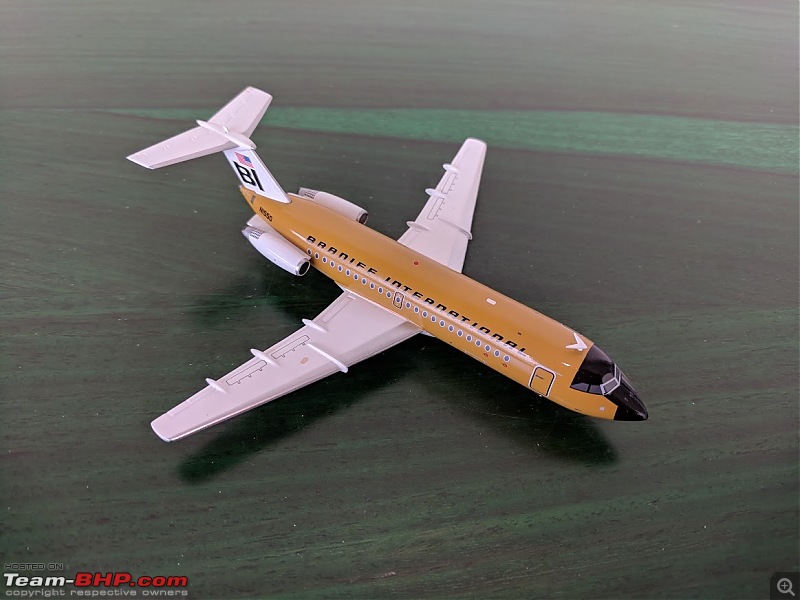 Basic fuselage for 5-abreast which is the minimum that can allow space for a luggage hold beneath the cabin floor.  T-tail and aft mounted engines.  Note gentle sweepback of wings to aid softer take-off and landing speeds. Note the thrust reversers on the back most portion of the engines.  The BAC-111 was designed with short landing gears which made it easier to access the under-floor cargo holds.  Wingplan form of the Caravelle (top), BAC-111 (left) and Tupolev Tu-134 (right). The Caravelle & BAC-111 have small sweepback wings while the Tu-134 has a steep sweepback for higher cruising speeds. Though all three were of similar passenger size (80 to 100) the Tu-134 needed a higher cruising speed for the vast distances in Russia.  Note the landing gear arrangement. Tu-134 (left) with 4-wheel bogies, for rough landing strips, rolling into wing mounted training edge nacelles. The Caravelle carrying a heavy duty 4-wheel bogie with a more traditional turn in to the fuselage. The BAC-111 featured the now common 2-wheel bogie. The BAC-111 interestingly is the first jet airliner to feature a 2-wheel bogie in its main landing gear.  The three aft mounted twins from the first generation of jet liners. Missing is the DC-9. Quote:
The Meiji restoration era starting ~1868 was a path breaking modernization of Japan and adoption of modern technology at a break neck speed. So much so that by 1905 the Japanese had built a Navy - equipped and trained by the Royal Navy - that defeated the Russian fleet in the Battle of the Tsushima. An Asian power defeating a white power had reverberations across the world and gave hope to the enslaved colonial subjects. This news even reached African Masai tribes in Kenya in an era before modern communication! - such was its impact. Japan continued to follow a policy of aligning with the British and buying their equipment and training and then gradually developing their own. They did this with characteristic Jap zeal and efficiency. By 1922 ie 54 years since the start of the Meiji Restoration they commissioned the world's first aircraft carrier, IJN Hosho, designed from the start as such. Some of their technology was purchased, some was copied and a lot was home grown over the 70 odd years till their entry into WW-II. Those 70 years saw Japan embracing mechanization and modern science at a zealous pace. The West, clouded by the thinking of superiority of those times did not fully notice how much progress Japan had made and looked down on them. Prior to WW-II Japan had effectively taken over Korea in 1905 and subjected its population to a miserable and cruel bondage. In 1931 it then attacked and captured, over 7 years, vast swathes of Eastern & coastal China and all of Manchuria. Again a very cruel and ruthless occupation. | |
| |  ()
Thanks ()
Thanks
|
| | #755 | |
| BHPian Join Date: Mar 2013 Location: Bangalore
Posts: 241
Thanked: 3,398 Times
| re: Scale Models - Aircraft, Battle Tanks & Ships Quote:
On another note, the transformation of Japan from a feudal minded, brutal imperial power to one of the most peaceful nations has been a blessing for the world. They have contributed so staggeringly in terms of industrial practices, technological innovation and discipline. | |
| |  ()
Thanks ()
Thanks
|
| | #756 |
| BHPian Join Date: May 2009 Location: NYC / Lucknow
Posts: 703
Thanked: 4,129 Times
| Scale Models - Aircrafts & Ships
One more unique (but ungainly) British aircraft in your collection  (Although beauty is in the eye of the beholder!) I have seen this model a few times and wonder how it managed to fly with those stubby wings and thick fuselage. (Although beauty is in the eye of the beholder!) I have seen this model a few times and wonder how it managed to fly with those stubby wings and thick fuselage. I think pretty soon your collection will have all major airliners ever produced. 1:400 Trans World Airlines Boeing 747-131 'N93103'    The real plane.  As a lot has been written about the 747, something about the airline: Trans World Airlines (TWA) was a major American airline that existed from 1930 until 2001. It was formed as Transcontinental & Western Air to operate a route from New York City to Los Angeles via St. Louis, Kansas City, and other stops, with Ford Trimotors. With American, United, and Eastern, it was one of the "Big Four" domestic airlines in the United States formed by the Spoils Conference of 1930.[4] Howard Hughes acquired control of TWA in 1939, and after World War II led the expansion of the airline to serve Europe, the Middle East, and Asia, making TWA a second unofficial flag carrier of the United States after Pan Am.[5][6] Hughes gave up control in the 1960s, and the new management of TWA acquired Hilton International and Century 21 in an attempt to diversify the company's business. As the Airline Deregulation Act of 1978 led to a wave of airline failures, start-ups, and takeovers in the United States, TWA was spun off from its holding company in 1984. Carl Icahn acquired control of TWA and took the company private in a leveraged buyout in 1988. TWA became saddled with debt, sold its London routes, underwent Chapter 11 restructuring in 1992 and 1995, and was further stressed by the explosion of TWA Flight 800 in 1996. In 2001, TWA filed for a third and final bankruptcy and was acquired by American Airlines. American laid off many former TWA employees in the wake of the September 11, 2001 attacks and closed its St. Louis hub in 2003. Only plane I have in all the standard scale sizes: 1:500 Air France Boeing 747-400, 1:400 TWA 747-100, 1:200 Pan Am 747-100 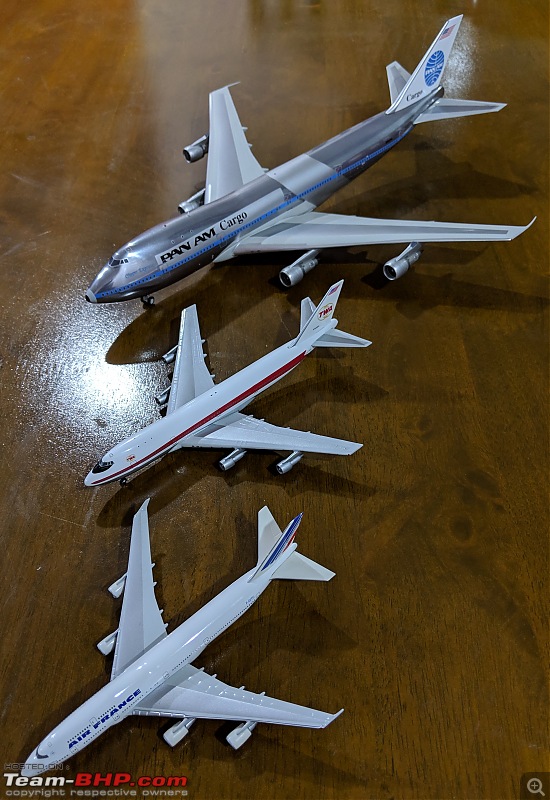 I bought this particular model only for nostalgia to gift to my parents: My family flew from New York to New Delhi and back in 1992 and part of the journey was on a TWA 747. I remember as child exiting the plane at JFK and looking up at the spiral staircase and wondering what was up there. The 1:400 size is pretty strange, same level as detail as a 1:500 model and just marginally bigger in size. |
| |  ()
Thanks ()
Thanks
|
| | #757 | ||||
| Distinguished - BHPian  Join Date: Aug 2014 Location: Delhi-NCR
Posts: 4,330
Thanked: 72,411 Times
| re: Scale Models - Aircraft, Battle Tanks & Ships  Quote:
 The British were willing to give us license assembly rights for the BAC-111. But the whisper of a discussion, in the early 1970s, never saw the light of day. Air travel like air-conditioners and cars was a sinful luxury to be scorned by the short sighted decision makers of that time. It could have given us a leg up and break through into the world of airliner production. The British were willing to give us license assembly rights for the BAC-111. But the whisper of a discussion, in the early 1970s, never saw the light of day. Air travel like air-conditioners and cars was a sinful luxury to be scorned by the short sighted decision makers of that time. It could have given us a leg up and break through into the world of airliner production.Hey, you missed my La-7. Your Russkie roots are getting soft. Quote:
Quote:
Quote:
| ||||
| |  ()
Thanks ()
Thanks
|
| | #758 | |
| Senior - BHPian | re: Scale Models - Aircraft, Battle Tanks & Ships 1:100 F-14D Super Tomcat US Navy VF-2 "Bounty Hunters" Last Tomcat Cruise 2003(Amer Com) A model of the VF-2 F-14D as seen during VF-2's Last cruise with the Tomcat in 2003.   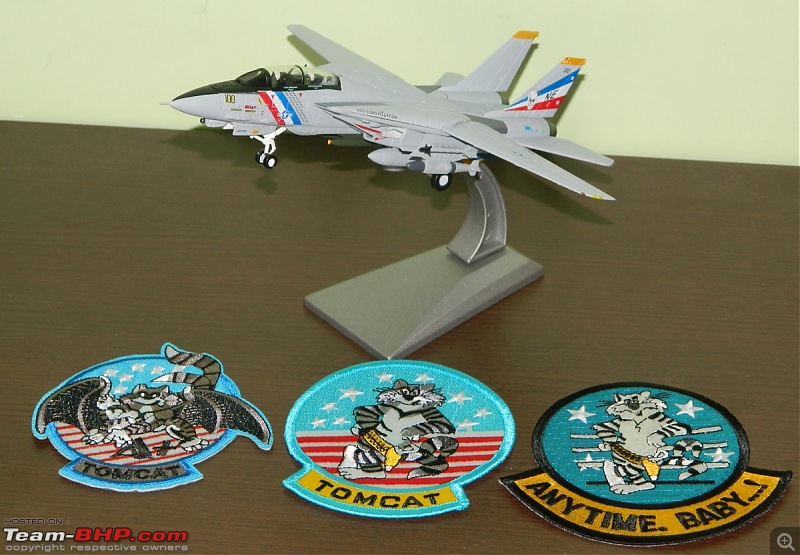  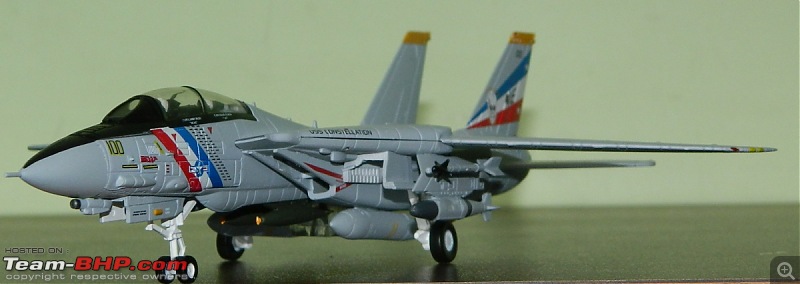    Model armed with 4 X Mk.82 500-lb bombs, 1 X GBU-32 JDAM, 2 X AIM-9 Sidewinder, 2 X F-14 drop tanks & 1 X Litening LDP. The evolution of the Tomcat from from a pure Fleet Defender to a bomber is truly fascinating. 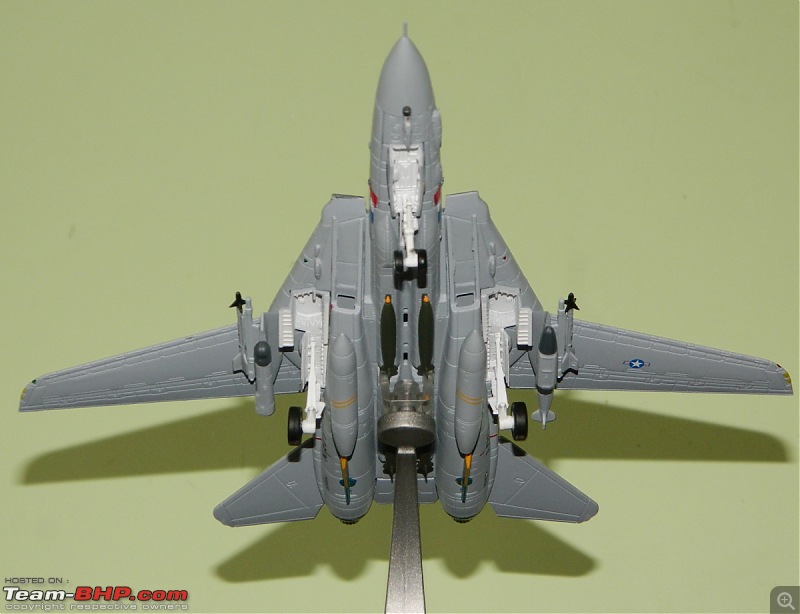 USS Constellation was homeplate of VF-2 Tomcats on their last Tomcat cruise in 2003. Name of the Pilot (Capt Larry Burt, DCAG, CVW-2) & his RIO (Capt. Craig Geron, CAG, CVW-2). Note the bomb markings on the aircraft - no. of bombs dropped by this aircraft during OIF.   Last Tomcat Cruise Marking on the fin  F-14D, Bureau Number 163894 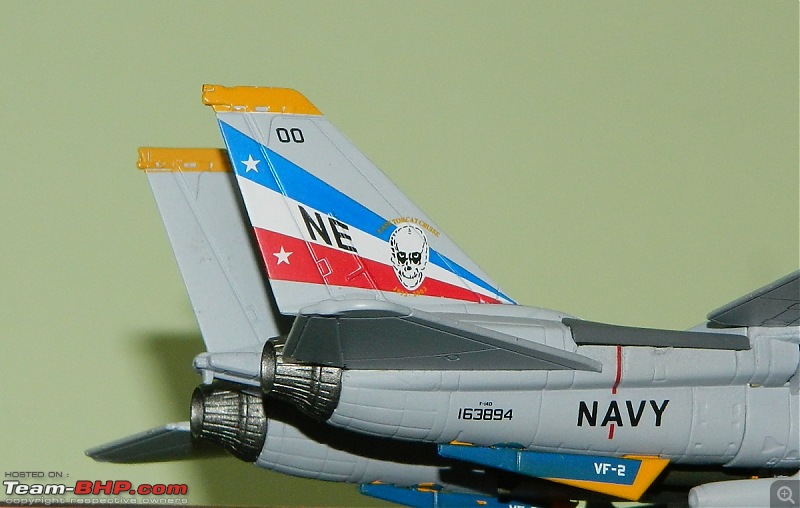 The real VF-2 F-14D Bureau Number 163894  163894 was a remanufactured F-14D(from F-14A) and built on 30.09.1990. It first flew with VF-124 "Gunfighters" in May 1993 as NJ432. Became part of VF-2 as NE100 in April 2001. After VF-2 retired their Tomcats, this airframe became as part of VF-101 "Grim Reapers" as AD156 from October 2004 till the squadron's deactivation in Late 2005. VF-2 "Bounty Hunters" VF-2, known as the "Bounty Hunters," was established on 14 October 1972 flying the F-14A Tomcat. VF-2 completed aircrew training and received its first Tomcats in July 1973, attaining full strength of 12 F-14As in the spring of 1974. VF-2's initial deployment was in 1974 with her sister squadron VF-1 "Wolfpack" aboard USS Enterprise. The squadron flew over Saigon in support of Operation Frequent Wind, the evacuation of US personnel from Vietnam in April, 1975. Lt. Cdr. Jay B. Yakeley of VF-2 was one half of the first F-14 crew to intercept a Tu-95 Bear in the Pacific. Later in the cruise VF-2 also became the first F-14 unit to intercept an IL-38. VF-2 returned to NAS Miramar on 29th March 1977. In the months after the return Lt. Cdr. Yakeley become the first F-14 pilot to log 1000 hours on type. VF-2 took part in Desert Storm aboard USS Ranger, the carrier being one of two forward deployed into the Persian Gulf. VF-2 flew over 500 combat missions and and 1900 combat flight hours during the 43 day war. Unfortunately the squadron did not have the opportunity to engage any Iraqi targets and had to be content with escort, recon and CAP missions, playing an important part in ensuring the safety of Navy bombers to and from targets. After the 1992-1993 cruise, USS Ranger was decommissioned (along with VF-2’s sister squadron, VF-1), and VF-2 was switched to the USS Constellation. At the same time, VF-2 transitioned to the F-14D Tomcat. In April 1996, VF-2's F-14Ds were modified to carry the LANTIRN infrared targeting pod, giving them precision strike capabilities. During their 1999 cruise, VF-2 supported Operation Southern Watch and on September 9, attacked Surface-to-Air Missile sites and anti-aircraft guns around Basra. The same day, a VF-2 Tomcat engaged 2 Iraqi Air Force MiG-23’s that were heading south into the No-Fly Zone from Al-Taqaddum Air Base, west of Baghdad with AIM-54 Phoenixes. The missiles did not score as the MiGs turned north once they detected the missile launch. In 2003, VF-2 was deployed aboard the USS CONSTELLATION with CVW-2 and participated in Operations ENDURING FREEDOM, SOUTHERN WATCH, and IRAQI FREEDOM, flying over 2000 combat hours and 483 sorties with over 320,000 pounds of ordnance expended. On 28 February 2003, during Operation SOUTHERN WATCH, Bullet 111, flown by Cdr Dave "Burner" Burnham and Lt. Justin "Donger" Hsu, delivered the first F-14D JDAM in combat. Quote:
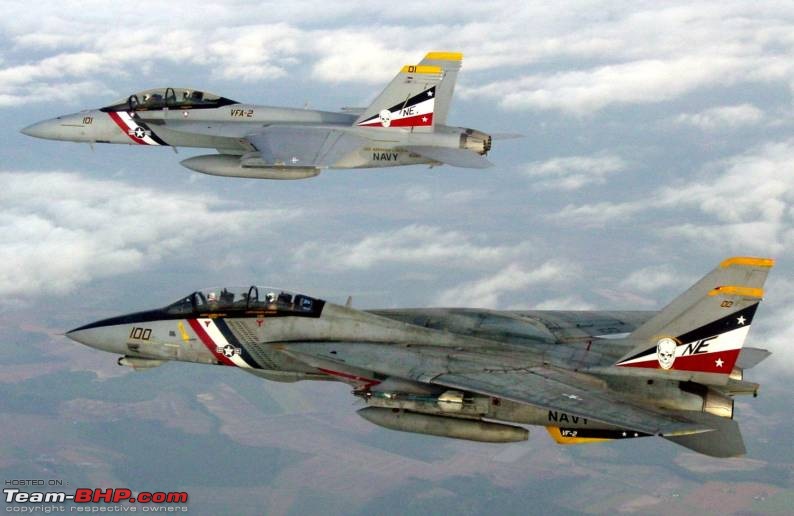 On 1 July 2003, VF-2 was officially re-commissioned as VFA-2, thus beginning transition training to the F/A-18F Super Hornet. With the Hogan 1:200 VF-2 F-14D - same markings & same Bureau No.     Just last week it was confirmed the F-14 will be making comeback in the upcoming movie Top Gun 2. Long live the Legendary Tomcat!!!! Last edited by Jaggu : 25th February 2019 at 13:04. | |
| |  ()
Thanks ()
Thanks
|
| | #759 |
| Distinguished - BHPian  Join Date: Aug 2014 Location: Delhi-NCR
Posts: 4,330
Thanked: 72,411 Times
| re: Scale Models - Aircraft, Battle Tanks & Ships
Congratulations on another great Tomcat tailfin. The two look like big eagle and baby eagle together. Thank you for the full history of the aircraft and the squadron. Why not share a photo of all your Tomcats together. |
| |  ()
Thanks ()
Thanks
|
| | #760 | |
| Senior - BHPian | re: Scale Models - Aircraft, Battle Tanks & Ships Quote:
Here they are: 1:72 Easy Model VF-143 "Pukin' Dogs" F-14B 1:100 Amer Com VF-2 "Bounty Hunters" F-14D 1:200 Hogan VF-111 "Sundowners" F-14A 1:200 Hogan VF-2 "Bounty Hunters" F-14D 1:200 Hogan IRIAF Desert camo F-14A 1:200 Hogan IRIAF Twin tone blue camo F-14A    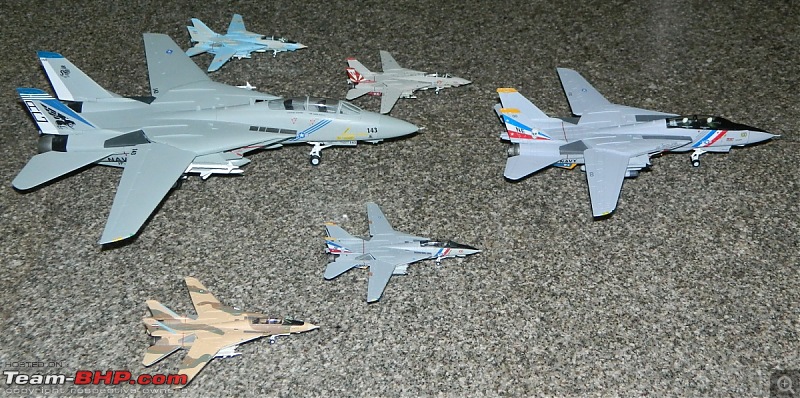  The Hogan Tomcats are the best in terms of detailing and shape. | |
| |  ()
Thanks ()
Thanks
|
| | #761 |
| Distinguished - BHPian  Join Date: Aug 2014 Location: Delhi-NCR
Posts: 4,330
Thanked: 72,411 Times
| re: Scale Models - Aircraft, Battle Tanks & Ships
Simply gorgeous. Thank you for putting the photos together and all the effort. It is interesting to see the scale between 1:72 and 1:200. In 1974 when I first read of the Tomcat in some aviation magazine the aircraft's capabilities seemed other wordly and it seemed utterly impossible that we would ever learn how to develop such technology and missiles (Phoenix) and long range radars. That was a time before Aryabhat or even Pokharan - I. But now bit by bit we are getting there. The raw power of an F-14 has always excited the aircraft boy in me. |
| |  ()
Thanks ()
Thanks
|
| |
| | #762 | |
| BHPian Join Date: May 2009 Location: NYC / Lucknow
Posts: 703
Thanked: 4,129 Times
| re: Scale Models - Aircraft, Battle Tanks & Ships Quote:
 The 1/72 Easy Model is my favourite in terms of detailing and size although its very fragile. Do you think the Hogan is more detailed that that one ? It seems the IL-62M was operated from RGIA Hyderabad airport for sometime (although not absolutely sure that is true since the new airport is only 11 years old), I noticed today the parking area has markings for it along with the retired Airbus A300-600.  Last edited by Foxbat : 23rd February 2019 at 18:04. | |
| |  ()
Thanks ()
Thanks
|
| | #763 |
| Distinguished - BHPian  Join Date: Aug 2014 Location: Delhi-NCR
Posts: 4,330
Thanked: 72,411 Times
| re: Scale Models - Aircraft, Battle Tanks & Ships
Very observant of you Foxbat. It must have flown out of Hyderabad. Maybe those markings are for Aeroflot or just kept there for the odd plane that may come. The Air India IL-62M used to definitely fly out of Palam, New Delhi now IGIA. |
| |  ()
Thanks ()
Thanks
|
| | #764 |
| Distinguished - BHPian  Join Date: Aug 2014 Location: Delhi-NCR
Posts: 4,330
Thanked: 72,411 Times
| re: Scale Models - Aircraft, Battle Tanks & Ships Unsuccessful Airliner but the most successful submarine hunter Lockheed Electra L-188; medium range turbo-prop airliner; 1:200 scale JC wings Wingspan 6 inches; Length little over 6 inches The Lockheed L-188 Electra is the only large turboprop airliner from USA. First flown in 1957. In terms of speed, climb, fuel efficiency per passenger-mile it was outstanding for its time. In fact on fuel cost per passenger-mile and time to destination it could give stiff competition to the regional jets of today on all sectors less than 500 kms. Initial sales were good, but three fatal crashes in 1959 & 1960 led to expensive modifications to fix a design defect and no more were ordered beyond the first 180. It had a high power-to-weight ratio, paddle propellers, large Fowler flaps, most of the wing being washed by the prop wash and all these gave it an excellent short field and hot and high capability unmatched by regional jetliners even today After the third crash, the FAA limited the Electra's speed until the cause could be determined. After an extensive investigation, two of the crashes (in September 1959 and March 1960) were found to be caused by an engine mount problem. The mounts were not strong enough to damp a phenomenon called "whirl mode flutter" similar to the spinning of a child's top as it slows down and starts swaying as it rotates with the sway factor increasing with each rotation. The outboard engine nacelles were vulnerable to this. For example a heavy landing could cause a hairline fracture to the outer engine mounting which would then allow a slight oscillation of the engine mounting+propeller to develop. When the oscillation was transmitted to the wings and the flutter frequency decreased to a point where it was the same as the natural resonance of the outer wing panels (at the same frequency, or harmonically related ones) the wing itself would start vibrating at its own harmonics. This would lead to a violent up-and-down oscillation until the wings would tear off! While a long explanation the entire sequence took place in minutes. Lockheed rectified all aircraft at its own cost. It also improved our knowledge of the role of harmonics in aircraft structural design. Today great care is taken to deliberately ensure that the resonating frequencies of the turbine, the cowlings, the pylons, the wings etc are all out of sync with each other. The L-188 was not successful commercially because of this though the modified & corrected fleet gave sterling service for 30 to 45 years. Lockeed developed the aircraft into its sister variant the anti-submarine warfare (ASW) P-3 Orion of which 757 were built making it the most successful ASW aircraft ever. Length: ~100 feet Wingspan: ~ 104 feet Cruise Speed: 600 kmph Passenger payload: 80 to 98 depending on configuration Effective Range: ~3000 kms with reserves and maximum payload 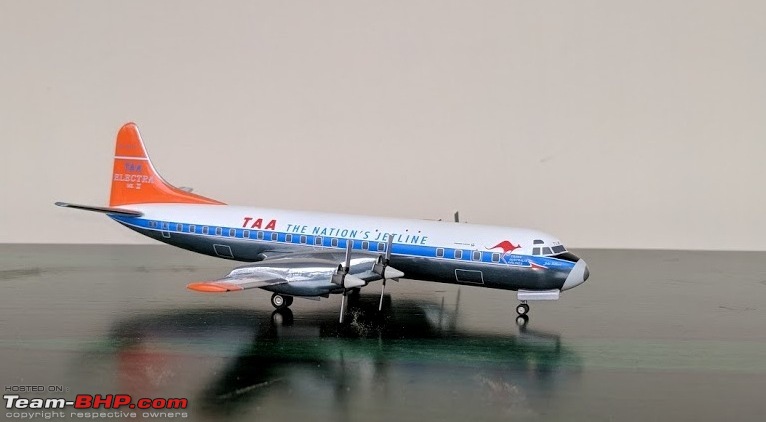  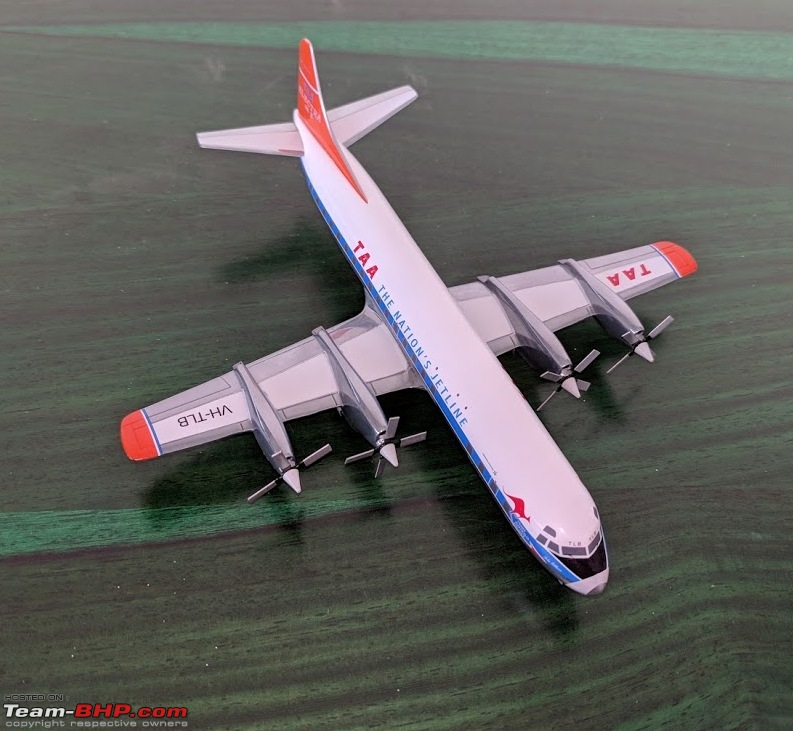 In those days it helped to link each aircraft to Jets. Hence many an airline livery carried the words 'propjet' or jetline for 'jetprop' for turdo-prop engine airliners.  Three contemporaries. Vickers Viscount - 50 to 65 pax and 1600 kms range; Bristol Britannia designed as long range high pax capacity airliner and for some years the longest ranged airliner in the world in the 1950s; Lockheed L-188 Electra - medium range - medium capacity airliner. Attachment 1851450  In real life P-3C Orion Anti-Submarine Long Range Maritime Patrol aircraft; Japanese Air Self Defence Force; 1:200 Hogan The Electra was modified to serve as a anti-submarine warfare {ASW} and long range maritime patrol {LRMP} aircraft. Later the Harpoon missile gave it a very real anti-ship capability too. The structure was strengthened for long hours of low altitude cruise patrol flying which as most of you know is several several times more stressful on the airframe than high altitude cruising. The engines were upgraded from 3950 eshp to ~4600 eshp and made more salt corrosion resistant. 'Eshp' stands for effective shaft horse power i.e. it includes the pushing power of the residual exhaust thrust going out at the back after most of the energy has been extracted by the turbines. It can add a further 3% to 7% to overall thrust. Thus, was born the P-3C Orion which with 757 built is the most prolific ASW and LRMP aircraft ever produced despite the fact that it was a the most expensive aircraft of its type lavishly endowed with sensors, computing power and weapons and remained the most expensive LRMP till the Boeing P-8 came in. It entered service in 1962. Hundreds are still in service and they are expected to fly in frontline squadrons till the mid-2030s at least. P-3’s are armed with homing torpedoes, depth charges, sea mines, Harpoon anti-ship sea skimming missiles, AGM-65 Maverick precision air-to-surface missile and the AGM-84 land attack missile. Their typical patrol endurance is 10 to 12 hours which can be increased by air-to-air refueling. This is similar to the one in post 291 owned by skanchan95. skanchan95's purchase motivated my own. Thank you brother.    Beautifully detailed right down to every aerial.  Note detailing down to the convex observation window and stenciled safety markings.   Mouth watering detailing of the underside - note the aft sonobouy bay and the weapons bay forward of the wing, the 4 inboard pylons one of which has a sensor   Note 4 outboard pylons - 2 on each wing for the Harpoon anti-ship missile.  Lovely shot of the real thing. Note the long span fowler flaps inherited from the Electra for short take off and landing.   The two sisters |
| |  ()
Thanks ()
Thanks
|
| | #765 | |||
| Senior - BHPian | re: Scale Models - Aircraft, Battle Tanks & Ships Quote:
The Easy model F-14 is not even close to the Hogan Tomcat when it comes to detailing. Stencils, Hazard markings, Nav lights, Weapon details and colours and distinguishing F-14A/B/D model features have been clearly modelled on the HG Tomcat models, while on the EM model, most features are missing. Quote:
The Mangalore airport has makings for the Boeing 767 but I can assure you no 767 has ever Landed the Mangalore airport. 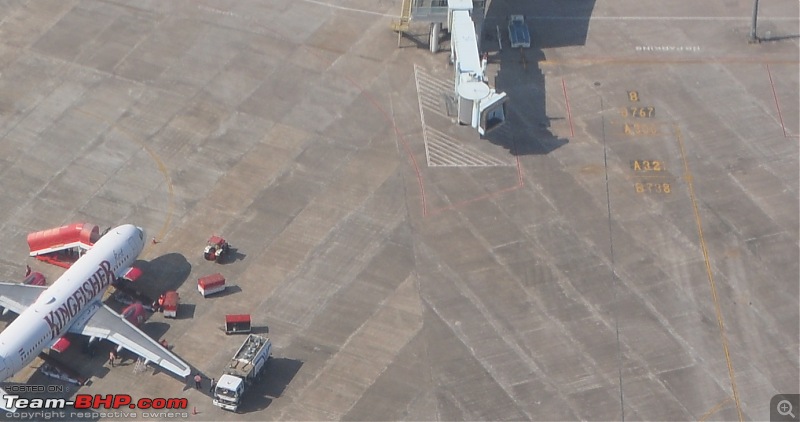 Quote:
The HG Orion model is easily the best diecast metal model out there. Orion models from JC Wings and JFox models don't even come close. The way Hogan has modelled all the antennas, minute stencils and markings on the model makes it a treat to own. Orions also have the capability to carry AIM-9s on the outer pylons. The AIM-9 was tested on the Orion, due to the experiences the British had in the Falklands campaign. RAF Nimrods encountered Argentinian patrol aircraft by chance during scouting missions. Unable to take action, the Brits quickly armed their Nimrods with infrared guided air-to-air missiles.  Being a four engined aircraft, the Orion has the capability to shut down two engines during its patrol phase. Once on station for patrol, one engine is often shut down (usually the No. 1 engine – the left outer engine) to conserve fuel and extend the time aloft and/or range when at low level. It is the primary candidate for loiter shutdown because it has no generator. Eliminating the exhaust from engine 1 also improves visibility from the aft observer station on the port side of the aircraft. On occasion, both outboard engines can be shut down, weight, weather, and fuel permitting. Long deep-water, coastal or border patrol missions can last over 10 hours and may include extra crew. The record time aloft for a P-3 is 21.5 hours, undertaken by the Royal New Zealand Air Force's No. 5 Squadron P-3B in 1972. The Pakistanis also used their Orions as a bomber in the Swat valley campaign. A US Navy EP-3E ARIES II intelligence aircraft. derivative of the Orion, was involved in a mid-air collision with PLANAF J-8II Finback in 2001, that killed the Chinese fighter pilot - a Lt. Cdr. The badly damaged EP-3E made an emergency landing at PLANAF airbase and its crew were held captive for three weeks.It later came to be known as the Hainan Island incident. I remember watching the damaged EP-3E on CNN and wondering how the pilot managed to save such a badly damaged aircraft. | |||
| |  ()
Thanks ()
Thanks
|
 |


